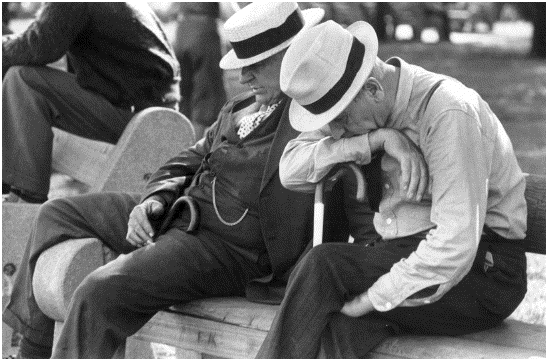
Long Time Coming
Photographic Portrait
Of America: 1935-1943
Michael Lesy, Editor
(Norton)

What stands out most of all in this superb volume --- over 400 stunning photographs drawn from the more than 140,000 at the Library of Congress --- is what we have lost. So soon after the close of WWII, this country began to turn strange. The great beast television quickly invaded each and every one of the towns and cities and farms portrayed here.The easy nature of interaction between people that was so much a part of the lives of America went away. Street-life disappeared. Center city was no longer a venue for life, but the home of junkies and viciousness. Roadways were set aside solely for cars, not for foot traffic. People who had once wandered the neighborhood and the downtown were in their living rooms or kitchens, huddled around the pale, gray, brutal light out of New York, Washington, or Hollywood.
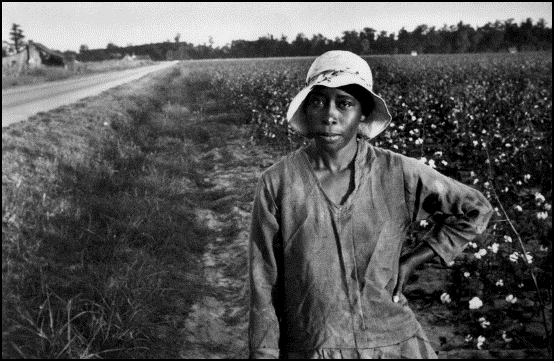
Here in this book we have a window on American life from sixty or seventy years ago and one cannot help but yearn for the way we were then, our fine innocence, the willingness to help, the desire ... no, the need to interact with others around us.It was a quiet joy, a trust in our surroundings and the people who made up our town or city life and there was, throughout, the knowledge that things would get better, that the world had life and an intensity of purpose that was America in 1935 or 1941.
We look at photographs of boys on their bicycles or girls jumping rope and know that now they would never be allowed out of the eyesight of their parents for a moment for the streets of America are lined with fear --- every city, town, village has had its wellspring of joy poisoned by the vision of anger and greed that the media dumps, daily, over us all --- the message that one's life is in constant danger, that there is a viciousness in the house next door, down the street, in the alleys, under the shadows that block the sunlight from what used to be the civil world and dreams of America.
Our America continues to be under assault by the mavens of a brute media, one that turns our children afraid in a world that was once civil, trusting, hopeful; makes them enforced paranoiacs who see mayhem and the threat of violence in every corner. It is no longer the American Way of Life, it is The American Way of Terror.
Viewing these pictures from that era --- even photographs of the most poverty-stricken families --- brings a troubling surety that the forces of darkness have, indeed, taken over this country --- that the simple pleasures, the simple lives, the simple ways of a simpler time have been pushed over the cliffs, into the muck of exploitation and brutal, blatant you-gotta-
buy-this. The cover of this volume shows us a somewhat ratty but well-intentioned hometown parade --- probably Memorial Day in Tulsa, or the Fourth of July in Bakersfield. It's a poignant vision, for now those days have been usurped. We no longer pass such holidays in communality, but going to Wal-Mart for "Holiday Specials," or --- more often --- parked before the television, watching a baseball game, each of us alone in our lonely chamber, away from those who should be part of our lives --- the neighbors, the villagers, our kinsmen --- those who once shared our common world, our common life.
Bertha Alyce:
Mother exPosed
Gay Block
(University of New Mexico Press)It's all so very strange: 150 or so photos of Gay, her mother Bertha Alyce, and the family: grandparents, mother, father, childhood, parties, marriage, Gay and her brother growing up, mother's second husband, mother's lover. Mother dressed up as an Indian, mother driving, mother getting a face lift (complete with stitches and bandages). Mother after the stroke. Mother almost always smiling.Gay started taking pictures when she was still young, still living at home:My first series consisted of portraits of people who were friends of my parents, mostly affluent, reform Jews who lived in Houston. The camera enabled me to enter these peoples homes and hear the stories of their lives ... The camera made me different from Mother even as it gave me access to her. It occurred to me much later that no matter who was in front of my camera, I was always photographing Mother."
After Gay left home, she would return from time to time to, apparently, fight with Bertha Alyce about what a lousy mother she was:
Gay. I didn't learn love from you...I don't remember you touching me...
Bertha Alyce: Now I really think you've had too much psychoanalysis, Gay.
Gay: And you had too little, like none.
Go to the complete
review
Juke Joint
Birney Imes,
Photographer
(University Press of Mississippi)They were called "juke joints" or "jook joints." They were the seedy places along the back roads that sold beer and set-ups --- in states with regressive liquor laws you could not buy booze over the counter so you brought your own, in a rumpled paper bag. The set-up was usually a cup, three ice cubes, and a bottle of Coca-Cola or Seven-Up.The booths had been slashed, the chairs were rickety, the pool table had gouges and cigarette burns in the felt, and the table was canted so that you had to make a scientific calculation to take the angle of the dangle into account.
The bathroom smelled of piss, vomit, and those little white candies that they dropped in the urinals along with the butts. The floors were trashy with stuff you didn't really want to examine too closely.
The regulars were a lewd lot. There was usually a brawl that was going to take place, or had just taken place, or was going on upon your arrival. Half the ceiling lights were burnt out, dead flies hung months old from ribbons of fly-paper; moths circled the few lights that survived. The tables were scarred from a hundred burning butts, the juke box had three-
year- old 45s that were so scratchy that the music could barely be heard above the hiss and poppings. The beer signs were the only lively, up-to-date accoutrement in the place. Beer was a dime and set-ups were a quarter. The bar-keep didn't care how old you were as long as you could reach the money up onto the bar.
There were always hand-lettered signs on the wall. In the men's room, it was "We Aim To Please You Aim Too Please." Behind the bar it was something about not being able to get a beer in the bank, so why would you expect credit here. The one in the picture above, Fig. 1, reads
Attention Please We Appreciate Your Business No Pot (double lines under the "o") Smoking OR Sale (double lines under the "a") in Here. Lucille Turner Thank You
The notion of pot is about the only change we can recognize in this gorgeous volume of photographs. It's oversized and sports almost sixty shots taken at Juke Joints in the delta area of Mississippi. Opening this was not unlike Proust's madeline. I was back there again, and as I turned the pages, I could smell the stale beer and piss, I could hear the Rock-Ola thrumming the wooden floor, I could feel the cigarette smoke burning my eyes, I could taste the ancient pickled pig's feet resting pinkly in the five-gallon jar on the counter, next to the punch-out board where for 25¢ you would stick in a metal spike, pull out a tiny piece of evanescent paper from underneath and learn that you had lost your chance to win a thousand dollars (but you got another free "you lose" punch).
Juke Joint made me pine for those hours that you and I spent in such places when we were young and rutting --- places where the music was off-key (often the 45s were not centered, Eddie "Cleanhead" Vinson went "wow-wow-wow") and the smoke was so thick you didn't even need to light up.
The jook joint ambience was the best in the world for those of us who were fourteen or sixteen or eighteen, just getting out of the house, out for a night on the town, all the menace and thirst and lust running us so our glands would be popping, overflowing with the juices that were just beginning to control our days, surge through our bodies now filled with needs and wants and fantasies and angers all barely formulated, so weird and new and strange that we would do anything: get blind drunk on Seven-and-
Seven, start a fight with some guy just because he looked funny at us, barf our guts out in the bathroom, pass out on the floor, face not far from that tacky residue under the urinals, where nothing and no one aimed to please.
Washington Sculpture:
A Cultural History of Outdoor Sculpture
In the Nation's Capital
Hames M. Goode
(Johns Hopkins)Editor Goode tells us there are over 500 outdoor sculptures in Washington, D. C. although at times it may seem like there are many more. He is generous, though, for he not only includes the equestrian statues and those national heroes with swords and busts, he brings in cemeteries, inner courtyards, hidden nooks ... and parts of Virginia and Maryland, too.They are gathered in this definitive volume, all are given at least one picture (sometimes several angled shots) and the whole weighs in at a ton or so (the book, not the busts). Washington Sculpture runs almost 800 pages.
It's a heroic effort and it is hard to stop leafing through it to see what other silly figures are to be commemorated in the traffic circles, parks, courtyards, sidewalks, cemeteries ... and sometimes right out on the city streets. One is tempted to try to make sense of all these colonnades and fountains and memorials and the only way I could figure out to do it was to list them by official scientific category.
Go to the complete
reviewLizardsA Natural History of
Some Uncommon Creatures
Extraordinary Chameleons
Iguanas, Geckos, and More
David Badger, Text
John Netherton, Photos
(Voyager Press)First of all, I don't believe that a man named Badger is writing a book about lizards. Second, if it is a Badger, and if he is telling the truth, he just stole part of my youth from me.I grew up in Florida, and I find on page 98 that the "chameleons" that we used to torture and used to be all over our house or climbing up the brick outhouse weren't chameleons at all but rather Anolis carolinensis --- better known as "Anoles." Sounds somewhat vulgar. Especially around the outhouse.
I also find out Anoles don't change color depending on what they are sitting (or standing) on. "Rather," says the author, "it is such factors as light, temperature, mood, excitement level, and physical activity." If you are an anole in a bad mood, you turn brown; if you are lusty, you turn green. Envious? Turn blue.
Thus Truman Capote might have been putting us on when he wrote that they were very fond of Mozart sonatas:
Eventually the chameleons accumulated, a dozen, a dozen more, most of them green ... They skittered across the terrace and scampered into the salon, a sensitive, absorbed audience for the music.
And when it was over: "The chameleons scattered like sparks from an exploding star." Except, now, of course, we know they were something else again.
§ § § This book has over 100 lovely pictures of our friends of the trees and walls and forests and rocks. There's the marine iguana that looks like your grandpop, the fire skink that appears to be dangerous but isn't (the only lizards that are dangerous are the Komodo Dragon of Indonesia "that has been known to attack and kill people" and the Gila Monster).
There's the Senegal Chameleon with those funny eyes that go every whichaway [See Fig. 1]. Then there is my buddy, the golden gecko which lives on the wall of my bedroom to the far south and makes a noise that one famous writer called kissing. He also thought it was a bird, called it "the kissy-kissy bird." Turns out it's not far from the truth --- this puckering sound is a gecko mating call, a call only geckos could love. Smack-smack.
Geckos are the only lizards with vocal cords, Badger tells us, and the word "gecko" is the sound the Tokay gecko makes, reported to be "a loud barking." Some drunks --- possibly drunk on Tokay --- reported that geckos hanging out (literally: on the ceiling) of a Malaysian billiard room produced "clicking sounds" not unlike that of the billiard balls. We don't know if they took up the game, beating the regulars by wrapping their tails around the cue stick. Someone was probably barking, or barfing.
Passing TrainsThe Changing Face of
Canadian Railroading
Greg McDonnell
(Boston Mills)
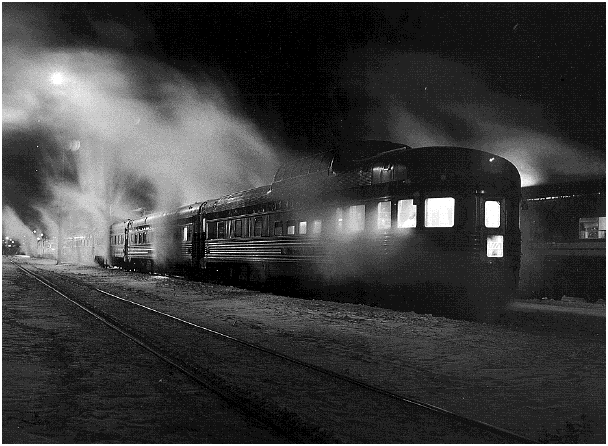
Do you remember so long ago you'd be on the train and you heard the grinding of the brakes and you'd wake up because all was still and you would lift up the shade next to your hole-in-the-wall bed and there just feet from you would be this out-of-nowhere depot with a few yellow light bulbs hanging down with their little black hats swinging in the wind over the snow- tracked platform and there would be nothing or no-one only an empty baggage wagon with its own load of snow pulled up against the dark wall of the station the frost edging the crusty windows the door closed against the night and you lying there in your bed with the fresh white clean crisp sheets and out there in the thin light the cold and desolation of some godforsaken town in Montana or North Carolina or Saskatchewan (Big Horn, Rocky Mount, Portage la Prairie) and you all alone with your vision thanking god that you are in and all that out there is out knowing that in a few moment's time if there is no glacier from god descending over this great long jointed train (and you) because you know you'll be gone from this isolated freeze-dry bone of the night-place in just a few moments, a place you hope you will never have to experience you safe and warm in your traveling capsule so safe from the wind blowing (blowing so hard the car rocks)...
...and then suddenly can you hear now the first pull of the engines catching up the cars and the whistle from so far up there to let you know that you are saved yet again not having to live in the ice-night of Spartenburg, Hardin, Medicine Hat, as now you are leaving it behind to its own icy fate as the lights pass one behind one behind now one now going faster one and then suddenly there at the very end of the platform a figure bulked earflaps and hat heavy coat comically this huge gloved bulked being against the last pangs of North Battleford, Livingston, Hickory now going by so quickly in his hand the lantern the three-ringed windows of green and red and yellow he now alone gone there left behind in a last frieze of air's breadth swirling the loose snow around now gone left behind there in Mount Airy, North Carolina, Bozeman, Montana, Swift Current, Saskatchewan.
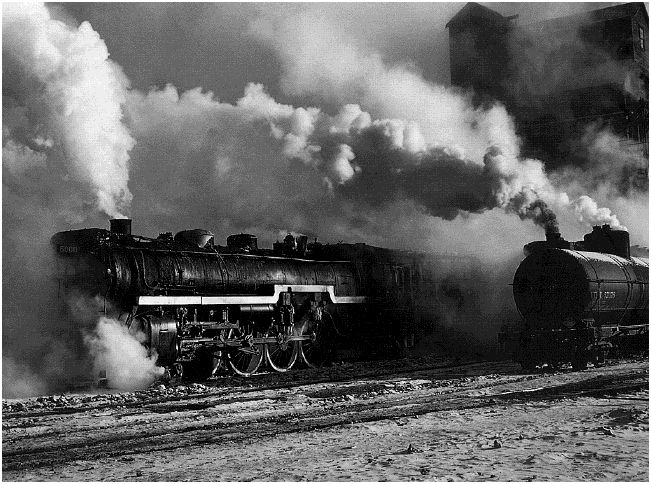
Go to the complete
reviewAt First Sight:
Photography and the Smithsonian
Merry A. Foresta,
Editor
(The Smithsonian Institution)Frog blood (1844), the moon (1863), the Pyramids of "El-Geezeh" (1858). Samurai in Japan (1863), Holy Trinity Church, London (1845), and a very sullen Emperor Meiji of Japan (1873).A not-very-sullen Genius "Engaged in Multiple Tasks" (1940), seven very dirty coal miners (1924), and a not smiling Thomas Smillie (1900). Six nervous newsboys in New York (1905), one giant waterwheel (1890), one bullet and three balloons in various stages of pop (1964).Fifteen merry thus probably innocent and not very blackfooted Blackfoots with tipi, Montana, 1890. Party-going rafters complete with banjo, ukulele and fishing pole (1910). And a hundred or so probably unwashed Union Army soldiers at Petersburg, Virginia (1864).
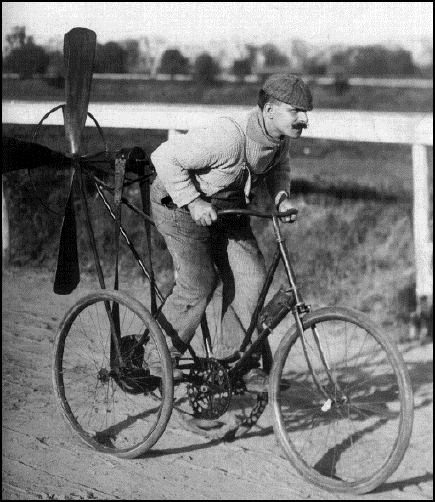
A very earnest looking fellow on bicycle with fan (or propeller, or tailwind) (1905). A very ugly Alopias vulpinus (Thintail Thresher) (1871), a very amorphous Himantura signifier (Stingray) 2002, and a very bony Pristigenys alta (Short big eye) (2002).A charming she-looks-
just-like- my-older- sister shot of Amelia Earhart with a lovely white Cord Phaeton (1936). A smirking Charles Lindbergh with Plane (1927), and Duke Ellington filled with fun and song (1960). § § § The photographs go all the way back to the very earliest printing experiments of 1840 or thereabouts, and include an 1846 shot of a model of the castle of the Institution. The early present is represented by some rather garish shots of Lucille Ball complete with pink veil, red lips, blonde hair, blue eyes. There is a winsome shot of Ansel Adams taken in a photo booth in 1930 (A self-portrait of Ansel Adams made in a photo booth!)
There are eight bombardiers hoisting eight 100-pound bombs to keep fit "for instantaneous action," just in case we were called to war and they had to heave these things from their cockpits (1950). There's Butch Cassidy and the gang looking just like turn-of-the-century bankers --- well, they were bankers, in a way. [See Fig. 4 below].There's Marian Anderson singing, in Washington, D. C., in 1939. Since she was black, and this was the time of segregation, the Daughters of the American Revolution, in what must be one of the great Public Relations moves of all times, refused to let her sing at Constitution Hall. Harold Ickes invited her to sing at the Lincoln Memorial. 75,000 people attended. Millions more listened on radio. Whatever became of the DAR, anyway? If you go to www.dar.org and type in her name, this is what you get:
Q. Why was famous black contralto, Marian Anderson, not permitted to sing at Constitution Hall in 1939?
A. The incident in 1939 was one of the first milestones in the struggle for Civil Rights in America. Washington, D.C., was a segregated city at that time and Constitution Hall limited performances to white artists. As the country began to tear down the barriers of race-discrimination, DAR followed suit and changed its policy for the Hall. Miss Anderson sang at Constitution Hall six times after 1939 and launched her farewell tour from our stage.
See: it wasn't the fault of the Daughters. It was the fault of society at large, or Washington D.C.
§ § § There are some 300 pages consisting of 150 photographs or so, drawn from the 13,000,000 photographs stored hither-and-yon in the sixteen museums that encompass the Smithsonian Institution. You figure it out: how does one go through 13,000,000 photos to cull a mere 150 for reproduction?
One thought on how this sumptuous book might have been even more so: dump the narratives --- the ho-hum history of photography in the Introduction and four other squibs ("Democracy of Images," "A New World," "Seeing as Believing," "Proofs Positive"). Let the pictures speak for themselves. We don't need words to tell us how fine and fascinating and interesting it all was and is. Another 150 shots might well have helped, at least to put a dint in those millions and millions looming over us, right now, as we speak.
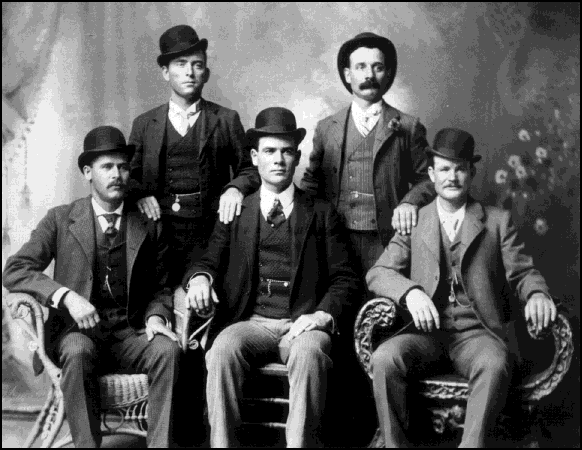
--- Lolita Lark
Go to the complete
articleArresting Time:
Erich Lessing
Reportage Photographs
1948 - 1973
Alastair Crawford, Editor
(Quantuck Lane Press/Norton)For sure, it was the time, a Europe laid waste by six years of war, then the Cold War, East and West Germany, the beginning of the Hungarian Revolution (workers at the Petöft Club) in 1956; John Foster Dulles (what teeth!) in Washington, 1959; Walter Ulbricht (Boo! Hiss!) in East Berlin, 1957; Cardinal Stefan Wyszynski (back from exile) Prague, 1956, Khrushchev (storming --- the U2!) in Paris, 1960; Willy Brandt (like a wind-up doll) in West Berlin, 1959; Bob Hope (mugging, always mugging) at the GUM Department Store, Moscow, 1958; Charles deGaulle (ortund, always ortund), Algiers, 1958; Rodion Malinovski, Soviet Minister of Defense (what an evil-looking guy: those lips, those eyes, those shoulders) Moscow, 1960......and the unknowns: workers building housing in Bytom, Poland, a fashion show in Vienna, a Bar Mitzvah in Krakow, brokers at the Bourse, West Germany, miners in Rhein, Altenessen, American Secret Service agents, Geneva (summit conference)...
...and the masses, a Soviet military band in Heldenplatz, Vienna, citizens in Kosovo (do things change?), Lenin Monument in Tbilisi, Georgia, 1958 (yes they do), children collecting scrap-metal, Berlin, 1951 (sometimes they change very quickly).
Well, part of this is just text to fill up the page so we can put up some photographs, much as the text in Erich Lessing may tell you a few things: a laudatory introduction by Alistair Crawford, ("People Known and Unknown"), fifteen chapters (which may or may not hold together), an interview with the subject ("How did you get into photography in the first place?"), a biography, a list of the ninety or so (!) books by Lessing, from 1956 to 2006, and some appropriate quotes, such as this of August Sander, 1876 - 1964,
Nothing is more hateful to me than photographs sugar-coated with gimmicks, posts, and false effects. Therefore, let me speak the truth in all honesty about our age and the people of our age.
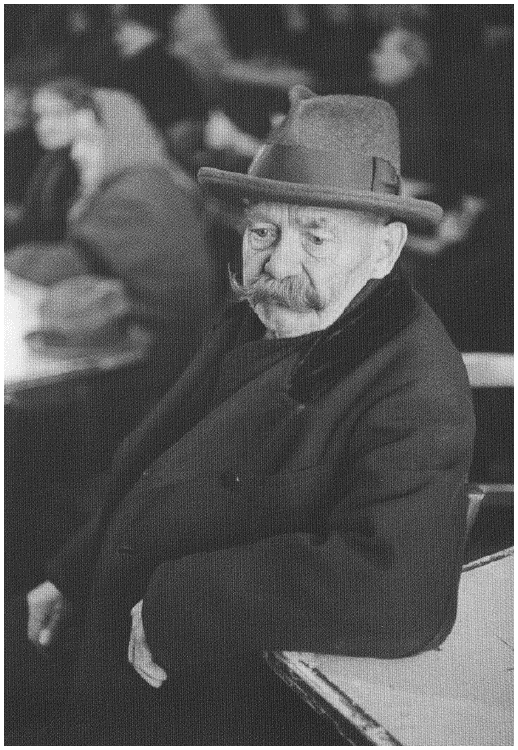 Go to the complete
Go to the complete
review
Snapshots of
Bloomsbury
The Private Lives of
Virginia Woolf and
Vanessa Bell
Maggie Humm
(Rutgers University Press)God knows why people are so dotty about the Bloomsbury Set. My guess is because they can so easily be put in a box. Mention Virginia Woolf or sister Vanessa or Lytton Strachey or John Maynard Keynes or Roger Fry --- and one can say, ah, yes, Bloomsbury: that slightly daffy, loose bunch of Bohemians, early 20th Century to 1940 or thereabouts.And even if you don't much care for all this Bloomsbury stuff, you pick up Snapshots and there you are, charmed out of your shirt by the beauty and privilege of their lives, clowning about in their straw hats at Monk's House, or standing before the Acropolis in Greece, or at the sea in Scotland, or at picnic at "High and Over."We might be jealous --- they looking so carefree, and merry, and fit (except for Leonard Woolf, who always looked ancient, never smiling, a revered keeper of the books, keeper of Virginia, perhaps --- if she could ever be said to be kept). There is E. M. Forster looking like a laid-back penguin; Lytton Stratchey in his forbidding beard and glasses, uncomfortable, geeky even ... a true Eminent Victorian, like he could never get naked, as did George Mallory [see below] or Vanessa and Molly McCarthy, in what my cousin Lillian would call "the nekkid-strip," the two of them playing a "ring of dancers," in 1913, just before it all fell apart.If you want to go back with lovely Virginia and lovely Vanessa, back to 1894, there they are, pretty as you please, in their black young-girls' Victorian long-underwear garments. And here we get to see them age, along with merry Oliver Strachey, in the window, and then in the buff; young Julian and Quentin Bell, in shots that would land the publisher in the pokey in present-day England, but I guess considered to be OK if you have a historical (not a hysterical) perspective.And then there is sweet Virginia, always about, with her calm woe, even when she is trying to try to be happy; and Vanessa, not looking at all introspective, certainly not woebegone, even appearing jolly, she was the one, no? who got them all to peel away their clothes, there in straight-laced pre-WWI England, before the fall and the mud and the trenches and the dying, so many of their young friends dying.
Even twenty years later, the fall, the one that did Virginia in, at last, in the stream, at the bottom of the hill, rocks in the pockets, and it fell apart, her despair, and the people, like that dried-out T. S. Eliot, with his tie and jacket and vest, no stones in his pockets, only gluey Brylcream on his hair, hair always parted just so, no wonder his wife went mad: hurry-up, please its time.
Then Roger Fry, the only one who looks like he's having a ball, so modern that his easel appears for all the world like a lap-top. And then too, the gossip written under the later shots --- Bloomsbury was always a hot-house of gossip, for those within, and those without. Under a photo of Sibyl Colfax: "the reason she is so dull that she never feels or thinks for herself." Or a prune-eyed Clive Bell, "I got a fantastic impression that this man Bell was a kind of Sun God --- with straw in his hair." Are we talking about the same Clive Bell, Vanessa? With that hair-do? And Ann and Judith Stephen: "great brown naked legged colts ... they dont wipe their mouths, & eat so much," writes Vanessa, wickedly.
This collection is rare, and fun, and lovely. Except for a couple of things. The first having to do with the editor, who, despite having a keen eye for photos and their placement, and knowing her stuff, can still write something as silly as, "The role of photo albums in their lives more resembles Foucault's account of the role of a mirror in heterotopology, which 'enables me to see myself there where I am absent.'" 'Allo? "Heterotopology?"
It, we find by Googling the word and trying to understand what we found, has to do with places. Foucault was a power freak, so, also, it has something to do with power being distributed everywhere, like the dying of the Big Bang. [Hetero = "other than usual;" topology = "study of a particular place."]
The other woe, for those who love her, is Woolf. She wrote a play in 1935 and it was called Freshwater. We have here a photo of Angelica Bell, now grown up. Comely. Playing the play, laid back in the water, eyes closed, all in white. "Presumed drowned."
Go to the complete
review
Past Tents
The Way We Camped
Susan Snyder
(Heyday/
Bancroft Library)When we went camping at Seymour's Point in north Florida, up near Fernandina, it was feast time for the the horseflies, the mosquitoes, the gnats and the no-see-ums that made their home there near the mud-flats. We would arrive on a Saturday around noon, go fishing up the Nassau River, and arrive back at six or so to clean the catch and get bit.There you are with a dozen half-dead drum, or grouper, or flounder, scale-scraper in hand, up to your eyes in mud and guts, and a midge buzzes your ear and you find yourself briefly wondering if this is the R&R you had promised yourself.
On Sunday, Uncle Ernest, who had far better sense than to be battling the bugs at dusk, appears on the dock at 6 A.M., bamboo fishing-pole in hand. He has gone down the clay bank to fiddler city and gathered ten or fifteen inch-long red-jointed crabs in a tin can for bait. He takes a fishhook and sticks the business end of it into the fiddlers at navel level. Then he lowers the whole wriggling and tiggling over the side of the dock into the swift-moving Nassau River. He's angling for sheepshead.
Ernest is patient, all Zen, alert to the smallest twitch at the business end of the pole. I had just discovered rEd Zern who had written about fishing as a silly tableau with a worm on one end and a nut-case on the other but Ernest is no idiot, doesn't use worms and, besides, the chowders he concocts (onion, potato, filet of sheepshead, butter, Tabasco) are the stuff of heaven.
This is North Florida at mid-century, and it couldn't last. Seymour's Point was soon laid to waste by the St. Joe Paper Company: They built a pulp mill upstream from our fishing area and within a year, the oysters and blue crab and fishing grounds had fallen victim to the sulfuric acid dumped as waste in the river. The crackers --- the poor folk who poached the land and worked odd jobs to supplement their diet --- ended up going to work in the pulp mill, ruining their lungs and getting $1.50 an hour so that the rest of us would have all the writing paper we could ever want.
The last time I visited Seymour's Point, they had built a condo overlooking the waters with an architectural style best described as "Trump Bleak Functional," and I could only dream of the times we kids had camped there, boiling up crabs for supper, eating bluepoint oyster fresh from the shells, lying down to sleep in wobbly little pup tents complete with pump-it-up Coleman lanterns complete with the two little bags that hung down to fill the night with a stark white light. There would be a pine-knot root sticking in your back, the air would be filled with the scent of creosote and an undefinable scent from the mud-flats. You'd be under a mosquito net to protect you from the song of the anopheles and there'd be the inevitable spooky shadows, shadows of flying things and creepy things and the occasional cougars that still roamed in the rural Florida countryside. Sleep would come soon, that sweet sleep of youth and innocence, in that innocent land from so long ago.
§ § §
Susan Snyder takes us back to these halcyon times. She opines that camping was slow to catch on in America because in the 19th Century, camping was all there was. When you wanted to get from West Virginia to Missouri, and from there to Oklahoma, and from there to the Nevada Territory and California, you camped your way across the country.
Sleeping under the stars and cooking over an open fire had been matters of necessity and expediency in trackless wastes that concealed wild beasts and nightmare sounds. Wilderness had been the formless enemy to be conquered and crossed at all costs.
"Now," she writes, "the trailblazers became pleasure trekkers, and trails that had been the routes of arduous travail become the paths of holiday jaunts."
Ms. Snyder has collected here over a hundred photographs to delight the soul: people dressed to the nines, posed formally outside their white-and-blue striped tents; three young fellows on high-front-wheel bicycles of the times, their packs carefully hung from the steering bar; a booted ruffian in a pork-pie hat standing before a wood-plank lodge marked WELLS FLAT; a "Silver Dawn" Sauerkraut can cut at both ends to serve as smokestack.
She has also culled readings from camping books of the day, advertising copy from the magazines filled with hints ("To dry matches: Carefully blot off as much water as possible with a soft cloth and then pass them through the hair a dozen times"), and clippings from those who ventured out into the wild:
"We ate our supper of cold venison and bread, and whittled from the sides of the wooden barometer-case shavings enough to warm water for a cup of miserably tepid tea, and then, packing our provisions and instruments away at the head of the shelf, rolled ourselves into our blankets and lay down to enjoy the view."
After such fatiguing exercises the mind has an almost abnormal clearness: whether this is from within, or due to the intensely vitalizing mountain air, I am not sure; probably both contribute to the state of exaltation in which all alpine climbers find themselves.
This entry by geologist Clarence King concludes: "The solid granite gave me a luxurious repose."
Go to the complete
review
Harker's Barns
Visions of an
American Icon
<Michael P. Harker
Jim Heynen, Text
(Iowa)What is it about these great behemoths that make them so attractive? Some are falling over, others are elaborate, with cupolas and windows, others half wood half siding, silos at one end (in one case, fallen over), stone, cross-hatch doors, overhangs, windmills. "Barns are the capitol buildings of a farm. The cupolas are capitol domes," says Heynen.The text may be redundant: what difference does it make? The seventy black-and-white photographs --- all from Iowa, such exotic towns as Tipton, Solon, Marengo, Bennett, West Amana, and a lovely fall-down, paint-flaked, roof-caved in number from Newhall --- lend themselves to being slashed out of the book and hung in your bedroom, study, or kitchen.
FOUNDation
Transforming Found Objects
Into Digital Assemblage
<Spencer Drate
(Watson-Guptill)Frida Kahlo's corset, a dirt cast sculpture hand, a Polaroid calendar, chopstick bags, pandas chewing on dollars ("Hello lazy panda ... we are here with the sack of live monkeys ... you requested ... they are very dirty sir ... just how you like them!"), poster for the RockCandy music club ("Engine kid sextet and deflowers at rockcandy march 10") and my most personal favorite, Bicycle lamp (p 70) by David Heasty.This is a collection of the wonderful and the strange, photo collages, announcements, birdhouses, print ads, typo kits, invitations, brochures, postcards, disc covers, postcard art, book covers (one of Seek My Face by John Updike is an eyecatcher --- which is, after all, the point, no?) It's all quite jarring, too. Especially the PeePod font [see below] which was inspired by those plastic filters that you find in men's urinals, right underneath the candy ("Photos were taken after extensive beer-drinking and peeing.")
What Was True
The Photographs and
Notebooks of William Gedney
<Margaret Sartor,
Geoff Dyer, Editors
(Lyndhurst/Norton)"They seem to be doing happy things sadly, or maybe they're doing sad things happily." The line is from John Cage, and William Gedney included it in a show of his photographs of the hippy world of San Francisco 1966 - 1967. And the black-and-white photographs show little of the supposed ecstasy of those years, but are, rather, zonked out young men and women, all looking this way or that, but not at each other, and certainly not very happy. This zonked out scene that we now tend to idolize is not the only part of this compelling book.
Shots from Kentucky, South Dakota, Brooklyn, Benares, Calcutta show people smoking, sitting in their cars, standing in doorways, playing cards, looking here and there: looking in store windows, looking at hands, looking at the camera, looking past each other --- and, so often, none of these people are connected. It's all very disturbing: it smells of sadness, loneliness, poverty, angst, isolation, meaninglessness. The Gedney archive now rests at Duke University, and the hundred or so images nicely reproduced here speak of a man who knew his craft well enough to show exactly what he wanted: that the world was a minefield of isolation, incomplete contacts and waiting, waiting, waiting.
We can love Gedney for his photographs, and can only wonder at the fact that he is so gracefully blind to the singularity of his craft when he writes, "I have spoken of India as a bittersweet land. It grows increasingly bitter. I have never let the bitterness show in my work."
American
Windmills
An Album of
Historic Photographs
T. Lindsay Baker
(University of Oklahoma)If you ever saw "Days of Heaven" --- that heavenly movie about the northern Great Plains --- the most characteristic noises of that flat country were the trains, and the wind, and the wind making the windmills creak and sigh. Windmills, as the author reminds us, were omnipresent, either to pump water from underground, or to mill wheat, rye, oats, or any other grains.
It's the essence of solitary, isolated, inward-looking, turn-of-the-century American life, this sentinel hovering at the edge of the horizon, arms moving slowly, counting the winds, as it were. And, as you got closer, you would hear that mournful soughing, the wind passing through the great hands, moving the blades around and around and around. A sweet, sad sign out of our solemn pasts.
There are, in American Windmills, almost 200 black-and-white photographs of these sentinels of the continent, some from the late nineteenth century, some from as late as the 1950s.
As photograph collector John Carter explains, in his windy introduction --- complete with the word "ontologically" offered up not once but three times --- if you passed through the Great Plains a hundred years ago, the most obvious structure would be either a church steeple or a windmill. Or, we might suppose, what they called the hangman's "cradle." The names of the manufacturers were displayed on the single back blade behind the windmill, one that kept it oriented towards the wind: Star Mill, Standard, Plymouth Iron, Atlanta Wind Engine, Wonder, Kregel, Challenge, Dempster, Sampson. For free Sears would paint in the name of the owner of the windmill for all to see.
Families would gather to be photographed outside the house (often a sod hut), with horses and cows and the windmill --- for, the author surmises, the pumping mechanism might have been the most expensive item on the farm. Some of the structures are shown here in disarray, fallen, blasted apart, for the constant winds that blew often blew too hard.
There are some homemade structures, eccentric, a few artistic, one made from barrels split down the middle and welded onto the rotators. There are the multiple displays of many windmills, gathered together temporarily like foolish giants for the annual County Fair. A dozen or so were erected in Griswold, Iowa for a fish farm. Oliver Parker Fritchle combined a windmill with a dynamo to power a house at Warminster, Colorado, and painted "Fritchle Wind-Electric Light" on the guiding tail.
This is a fine book for those of us who are nostalgically (perhaps neurotically) attached to America's robust experiments in living from a century back. We could only wish that the author had taken the time to explain how the hell a windmill actually pumps water. We can see how a simple gear system with grinding stones would make a fine mill for corn. We can imagine the use of a dynamo in the revolving head for electricity. But we still cannot figure out how this armed monster --- one whose waving arms would send a Don Quixote raging into battle --- can transform a vertical rotary motion into one that can lift liquids from the depths.
Go to
the complete
reviewChildren of the Depression
Kathleen Thompson,
Hilary MacAustin, Editors
(Indiana University Press)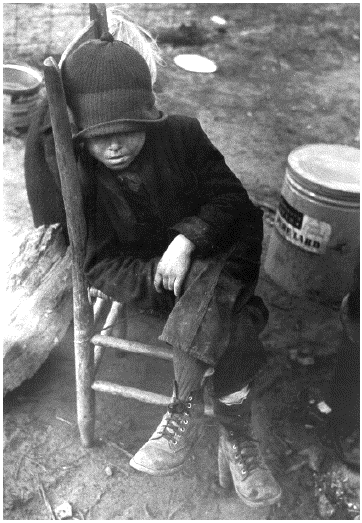 During the early years of the Depression in the United States, over 250,000 children were homeless, and, in some areas, 90% were malnourished.
During the early years of the Depression in the United States, over 250,000 children were homeless, and, in some areas, 90% were malnourished.In 1932, Clarence E. Pickett reported to Congress that --- depending on the school --- 20 - 90 percent of the children that the American Friends Service Committee had surveyed were underweight, suffering from rickets, pellagra, malnutrition, lethargy and sleeplessness.
In Chicago, 11,000 children in the public schools were being assisted by their teachers who paid for their food out of their own pockets. 3,000,000 children had to leave the educational system to take jobs, but there was no protection from exploitation because there were no child-labor laws.Over 15,000 young people were working in saw-mills, another 15,000 mining coal, and 5,000 more in steel mills. Younger children were paid less than the older ones --- in some cases they received not much more than 50 cents a week. Wages were as low as two cents an hour.
Beginning in 1935, the New Deal wanted to record its works to alleviate poverty, malnutrition, unemployment, low wages, and the general misery that was part of the Depression. It also saw the project as a chance to give employment to starving photographers. Roy Stryker was hired by the Resettlement Administration and the Farm Security Administration to find and give work to likes of Walker Evans, Arthur Rothstein, Dorothea Lange, Ben Shahn.Between 1935 and 1943, the RA and the FSA made more than 200,000 photographs of American life --- an astonishing record of the good and the bad of the U. S. The photographs were generally superb and the photographers given immense latitude in what they were to record.